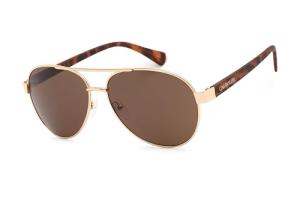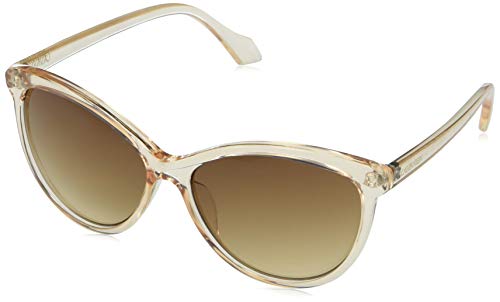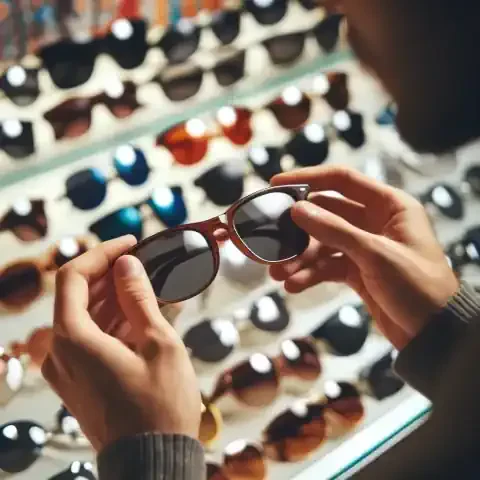Introduction
Sunglasses have become more than just a stylish accessory; they are a vital tool in protecting our eyes from harmful UV rays and enhancing visual comfort in various environments. Among the essential components of sunglasses, lenses stand out as the frontline defenders against glare, harmful radiation, and other environmental factors. In this comprehensive exploration, we delve deep into the realm of sunglasses lenses, unraveling their history, dissecting their types, and shedding light on the materials, coatings, and innovations that shape their performance and functionality.
Importance of Sunglasses in Eye Protection and Fashion
In today's world, sunglasses serve a dual purpose: safeguarding our eyes and making a fashion statement. The significance of protecting our eyes from the sun's harmful UV rays cannot be overstated. Prolonged exposure to UV radiation can lead to various eye conditions, including cataracts, macular degeneration, and even skin cancer around the eyelids. Sunglasses act as a shield, reducing the risk of these ailments and preserving our long-term eye health.
Moreover, sunglasses have become synonymous with style and personal expression. From classic aviators to trendy oversized frames, the options are endless, allowing individuals to reflect their personality and fashion sense through their choice of eyewear. The right pair of sunglasses can elevate any outfit, exuding confidence and sophistication.
Focus on Sunglasses Lenses as a Critical Component
While the frame of sunglasses often steals the spotlight, it is the lenses that truly determine their functionality and effectiveness. Sunglasses lenses play a pivotal role in filtering light, reducing glare, enhancing clarity, and providing UV protection. Different lens technologies and materials offer varying levels of performance, catering to diverse needs and preferences.
Understanding the intricacies of sunglasses lenses is essential for making informed choices that align with our lifestyle, activities, and visual requirements. Whether we're hitting the slopes, lounging on the beach, or simply commuting to work, selecting the right lenses can significantly impact our visual comfort and eye safety.
Overview of Sunglasses Lenses
This article embarks on a journey through the world of sunglasses lenses, starting with a historical perspective on their evolution and culminating in an exploration of the latest trends and innovations. We will delve into the different types of lenses available, ranging from polarized and photochromic to tinted and mirrored options. Additionally, we will examine the materials used in lens manufacturing, along with the coatings and treatments that enhance their performance and durability.
Furthermore, we will provide practical guidance on selecting the most suitable lenses for individual needs and offer maintenance tips to prolong their lifespan. Along the way, we will debunk common myths and misconceptions surrounding sunglasses lenses, empowering readers to make informed decisions when it comes to protecting their eyes and enhancing their style. So, let us embark on this enlightening journey into the fascinating world of sunglasses lenses.
History of Sunglasses Lenses
Origins of Sunglasses and Early Lens Materials
The origins of sunglasses can be traced back to ancient civilizations, where early forms of eye protection were crafted using natural materials such as bone, wood, and even gemstones. However, it wasn't until the 12th century that the concept of sunglasses as we know them today began to emerge. In China, flat panels of smoky quartz were used to shield the eyes from the sun's glare, marking the birth of the earliest recorded sunglasses.
As civilizations across the globe recognized the importance of eye protection, sunglasses evolved from mere practical tools to status symbols worn by nobility and clergy. In the 18th century, tinted lenses made from smoky quartz or tinted glass gained popularity among European aristocrats, primarily as a fashion accessory rather than for their protective qualities.
Evolution of Lens Technology Over Time
The 19th and 20th centuries witnessed significant advancements in lens technology, paving the way for the modern sunglasses lenses we use today. In the mid-18th century, James Ayscough experimented with tinted lenses made from various materials, laying the groundwork for the development of sunglasses with improved optical properties.
During the 20th century, sunglasses lenses underwent further refinement with the introduction of polarized lenses by Edwin H. Land in the 1930s. Polarized lenses offered superior glare reduction by selectively filtering out horizontally polarized light, making them ideal for outdoor activities and driving.
Milestones in the Development of Modern Sunglasses Lenses
The latter half of the 20th century witnessed a flurry of innovations in sunglasses lens technology. In 1965, the first photochromic lenses, capable of automatically adjusting their tint based on ambient light conditions, were introduced by Corning Glass Works under the brand name "PhotoGray." This breakthrough revolutionized the sunglasses industry, offering wearers unparalleled versatility and convenience.
Throughout the following decades, advancements in lens materials, coatings, and manufacturing processes continued to enhance the performance and durability of sunglasses lenses. From the introduction of impact-resistant polycarbonate lenses to the development of high-index plastics for thinner and lighter lenses, each innovation brought us closer to the pinnacle of sunglasses lens technology.
In summary, the history of sunglasses lenses is a testament to human ingenuity and the relentless pursuit of clarity, comfort, and protection for our most precious sensory organ—the eyes. As we journey through the following sections, we will delve deeper into the diverse array of sunglasses lenses available today, each building upon centuries of innovation and craftsmanship.
Types of Sunglasses Lenses
Sunglasses lenses come in various types, each tailored to specific needs and environmental conditions. Understanding the differences between these lenses is crucial for selecting the most suitable option for your lifestyle and activities.
Polarized Lenses:
Polarized lenses are designed to reduce glare and improve visual clarity, particularly in high-glare environments such as water surfaces, snowfields, and roads. They achieve this by filtering out horizontally polarized light, which is often reflected off flat surfaces. This selective filtering helps eliminate glare caused by sunlight bouncing off horizontal surfaces, enhancing contrast and reducing eye strain. Polarized lenses are highly recommended for outdoor activities such as fishing, skiing, and driving, where glare can pose a significant safety hazard.
Photochromic Lenses:
Photochromic lenses, also known as transition lenses, are designed to adapt to changing light conditions by darkening when exposed to UV radiation and fading back to their original state indoors or in low-light environments. This adaptive feature provides convenience and versatility, eliminating the need to switch between different pairs of sunglasses and regular eyeglasses. Photochromic lenses are ideal for individuals who frequently transition between indoor and outdoor settings, offering continuous UV protection and optimal visual comfort throughout the day.
Tinted Lenses:
Tinted lenses come in a variety of colors and shades, each offering distinct advantages depending on the intended use. Darker tints, such as gray and green, reduce overall brightness and provide natural color perception, making them suitable for bright sunny days. Meanwhile, lighter tints, such as yellow and amber, enhance contrast and depth perception in low-light conditions, making them popular choices for overcast days or activities such as shooting and cycling. Tinted lenses allow wearers to customize their sunglasses according to their preferences and visual requirements.
Mirrored Lenses:
Mirrored lenses feature a reflective coating applied to the outer surface, which reduces glare by reflecting a portion of the incoming light. This reflective coating also adds a stylish and futuristic aesthetic to the sunglasses, making them popular among fashion-conscious individuals. Mirrored lenses come in various colors and intensities, allowing wearers to express their personality and sense of style while enjoying enhanced visual comfort and protection.
Gradient Lenses:
Gradient lenses feature a gradual transition from a darker tint at the top to a lighter tint at the bottom, offering protection from overhead sunlight while allowing more light transmission through the lower portion of the lens. This design is particularly useful for activities where clear vision is required both near and far, such as driving and reading outdoors. Gradient lenses also add a touch of sophistication to sunglasses, making them a favorite among fashion enthusiasts.
In summary, the diverse range of sunglasses lenses available caters to a wide spectrum of needs and preferences, from glare reduction and UV protection to style and fashion. By understanding the unique characteristics of each lens type, individuals can make informed decisions when selecting the perfect pair of sunglasses for their lifestyle and visual requirements.
Lens Materials
The material used in sunglasses lenses plays a crucial role in determining their performance, durability, and overall quality. Advances in lens material technology have led to the development of various options, each offering distinct advantages and suitability for different purposes.
Glass Lenses:
Glass lenses were the traditional choice for sunglasses due to their exceptional optical clarity and scratch resistance. However, they are heavier and more prone to shattering than other materials, making them less popular in modern sunglasses. While glass lenses still offer unparalleled clarity, their weight and fragility have led to the emergence of alternative materials that prioritize safety and comfort.
Polycarbonate Lenses:
Polycarbonate lenses have gained widespread popularity for their lightweight construction and high impact resistance. Originally developed for safety eyewear and sports goggles, polycarbonate lenses are now commonly used in sunglasses due to their durability and ability to withstand rough handling. Additionally, polycarbonate lenses provide excellent UV protection, making them ideal for outdoor activities where eye safety is paramount.
High-Index Plastic Lenses:
High-index plastic lenses are engineered to be thinner and lighter than traditional plastic lenses, making them an attractive option for individuals with higher prescriptions. By using materials with a higher refractive index, high-index plastic lenses can achieve the same optical clarity as thicker lenses while reducing bulk and weight. This makes them more comfortable to wear, especially for those with strong prescriptions or who prefer sleeker frame styles.
Trivex Lenses:
Trivex lenses offer a balance of optical clarity, impact resistance, and lightweight construction. Developed as an alternative to polycarbonate lenses, Trivex lenses boast exceptional optical properties, including minimal distortion and chromatic aberration. Additionally, Trivex lenses are highly resistant to impact and scratching, making them an excellent choice for active individuals who require durable eyewear.
Other Specialty Materials:
In addition to the aforementioned materials, there are several specialty materials used in sunglasses lenses to cater to specific needs and preferences. These include NXT polyurethane lenses, which offer superior optical clarity and impact resistance, as well as mineral glass lenses, which provide unparalleled scratch resistance and optical performance. Each of these materials has its unique characteristics, allowing wearers to customize their sunglasses to meet their exacting standards.
In conclusion, the choice of lens material plays a significant role in determining the performance and durability of sunglasses. Whether prioritizing lightweight comfort, impact resistance, or optical clarity, there is a wide range of materials available to suit every preference and lifestyle. By understanding the properties of each material, individuals can make informed decisions when selecting the perfect pair of sunglasses to protect their eyes and enhance their visual experience.
Lens Coatings and Treatments
In addition to the choice of lens material, coatings and treatments applied to sunglasses lenses can significantly enhance their performance, durability, and visual clarity. These coatings serve various purposes, ranging from reducing glare and enhancing scratch resistance to improving overall optical quality and comfort.
Anti-Reflective Coating:
Anti-reflective (AR) coating is applied to the surface of sunglasses lenses to reduce glare and reflections, particularly from artificial light sources and bright sunlight. By minimizing glare, AR coating improves visual clarity and contrast, allowing wearers to see more clearly in various lighting conditions. Additionally, AR coating can enhance the aesthetic appearance of sunglasses by eliminating distracting reflections on the lens surface.
Scratch-Resistant Coating:
Scratch-resistant coating is designed to protect sunglasses lenses from scratches and abrasions caused by everyday wear and tear. This protective coating forms a hard, durable barrier on the lens surface, preventing minor scratches from compromising optical clarity. While scratch-resistant coatings cannot guarantee complete scratch prevention, they significantly extend the lifespan of sunglasses lenses, ensuring long-lasting performance and visual integrity.
UV Protection:
UV protection is a crucial feature of sunglasses lenses, as prolonged exposure to ultraviolet (UV) radiation can lead to various eye conditions, including cataracts, macular degeneration, and photokeratitis. High-quality sunglasses lenses are equipped with UV-blocking technology that filters out harmful UVA and UVB rays, providing reliable protection for the eyes. It is essential to choose sunglasses with lenses that offer 100% UV protection to safeguard against the damaging effects of UV radiation.
Hydrophobic Coating:
Hydrophobic coating is applied to sunglasses lenses to repel water, oil, and dirt, thereby improving clarity and ease of cleaning. This water-resistant coating creates a smooth, non-stick surface that prevents water droplets and other debris from adhering to the lens, making it easier to wipe away smudges and fingerprints. Hydrophobic coatings also reduce the buildup of moisture and fogging on the lens surface, ensuring clear vision in various weather conditions.
By incorporating these coatings and treatments into sunglasses lenses, manufacturers can enhance their performance and durability, providing wearers with optimal visual clarity, comfort, and protection. When selecting sunglasses, it is essential to consider the presence of these coatings and treatments to ensure long-term satisfaction and enjoyment of your eyewear investment.
Choosing the Right Lenses for Your Needs
Selecting the perfect pair of sunglasses lenses involves considering various factors, including your lifestyle, preferred activities, visual requirements, and personal style. With a multitude of options available, understanding the features and benefits of different lens types can help you make an informed decision that aligns with your specific needs and preferences.
Consideration of Lifestyle and Activities:
Begin by assessing your daily routine and the activities you frequently engage in. Are you an avid outdoor enthusiast who spends hours hiking, biking, or skiing? Do you spend long hours driving or working outdoors? Understanding your lifestyle and typical environments will help determine the most suitable lens features for your needs. For example, polarized lenses may be ideal for water sports and driving, while photochromic lenses offer convenience for individuals who transition between indoor and outdoor settings frequently.
Understanding Lens Features and Their Impact:
Familiarize yourself with the features and benefits of different types of sunglasses lenses. Consider factors such as glare reduction, UV protection, tint options, and lens materials. Polarized lenses are excellent for reducing glare and enhancing visual clarity, while photochromic lenses offer versatility in changing light conditions. Additionally, consider the durability and impact resistance of lens materials such as polycarbonate or Trivex, especially if you lead an active lifestyle or participate in high-impact sports.
Consultation with Optometrists or Eyewear Professionals:
Seeking guidance from optometrists or eyewear professionals can be invaluable in selecting the right sunglasses lenses for your needs. These experts can assess your visual requirements, prescribe lens options tailored to your prescription, and offer recommendations based on your lifestyle and activities. Optometrists can also provide valuable insights into lens technologies, coatings, and treatments that can enhance your visual comfort and eye protection.
By carefully considering your lifestyle, understanding the features of different lens types, and seeking expert advice when needed, you can confidently choose sunglasses lenses that not only meet your practical needs but also complement your personal style. Investing in high-quality lenses with the right features will ensure optimal visual clarity, comfort, and protection, allowing you to enjoy clear vision and enhanced eye safety in any environment.
Maintenance and Care Tips
Proper maintenance and care are essential for preserving the integrity and longevity of sunglasses lenses, ensuring optimal performance and visual clarity over time. By adopting simple cleaning and storage practices, you can protect your investment and prolong the lifespan of your eyewear.
Proper Cleaning Techniques to Prevent Damage:
When cleaning sunglasses lenses, it is crucial to use gentle methods to avoid scratching or damaging the lens surface. Begin by rinsing the lenses under lukewarm water to remove any loose dirt or debris. Then, apply a small amount of mild dish soap to your fingertips and gently rub the lenses in a circular motion. Rinse the lenses again to remove any soap residue, and pat them dry with a clean, lint-free microfiber cloth. Avoid using paper towels or rough fabrics, as they can scratch the lenses.
Storage Practices to Maintain Lens Integrity:
Proper storage is key to preventing scratches and other damage to sunglasses lenses when they are not in use. Store your sunglasses in a protective case whenever they are not being worn, preferably in a cool, dry place away from direct sunlight and heat sources. Avoid placing sunglasses lenses down on rough surfaces or tossing them into bags or pockets without protection, as this can lead to scratches and abrasions.
Handling Precautions to Avoid Scratches and Other Damage:
Handle your sunglasses with care to minimize the risk of scratches and other damage to the lenses. Avoid touching the lenses with your fingers, as oils and dirt from your skin can transfer onto the lens surface. Instead, hold the sunglasses by the temples or frame when putting them on or taking them off. Additionally, avoid placing sunglasses lenses face-down on hard surfaces, as this can lead to scratches and damage to the lens coatings.
By following these maintenance and care tips, you can protect your sunglasses lenses from scratches, dirt, and other damage, ensuring they remain in pristine condition for years to come. Regular cleaning and proper storage will preserve the clarity and integrity of your lenses, allowing you to enjoy clear vision and enhanced eye protection every time you wear your sunglasses.
Trends and Innovations in Sunglasses Lenses
The world of sunglasses lenses is continuously evolving, driven by technological advancements, changing consumer preferences, and emerging trends. From innovative lens materials to cutting-edge coatings and treatments, manufacturers are constantly pushing the boundaries of what sunglasses can offer in terms of performance, style, and functionality.
Advancements in Lens Technology:
Recent years have seen significant advancements in lens technology, leading to the development of lenses with enhanced optical clarity, durability, and performance. High-tech materials such as Trivex and NXT polyurethane offer superior impact resistance and optical quality, providing wearers with unparalleled visual clarity and comfort. Additionally, advancements in lens manufacturing processes have enabled the creation of thinner, lighter lenses without compromising on durability or safety.
Emerging Trends in Lens Designs and Functionalities:
In addition to technological advancements, there are several emerging trends shaping the landscape of sunglasses lenses. One such trend is the rise of customizable lenses that allow wearers to personalize their eyewear with various tint options, coatings, and treatments. Another trend is the incorporation of smart lens technologies, such as photochromic lenses that automatically adjust their tint based on light conditions, or lenses with built-in blue light filtering for digital device use.
Sustainable Materials and Eco-Friendly Initiatives:
With increasing awareness of environmental issues, there is a growing demand for sunglasses lenses made from sustainable materials and produced using eco-friendly manufacturing processes. Manufacturers are responding to this demand by incorporating recycled and biodegradable materials into their lens formulations and implementing environmentally responsible production practices. Additionally, some companies offer lens recycling programs to reduce waste and promote circularity in the eyewear industry.
As consumers become more discerning and environmentally conscious, we can expect to see continued innovation in the realm of sunglasses lenses, with an emphasis on sustainability, performance, and customization. Whether it's through the use of advanced materials, smart technologies, or eco-friendly initiatives, sunglasses lenses will continue to evolve to meet the ever-changing needs and preferences of modern consumers.
Common Myths and Misconceptions
Despite the widespread use and importance of sunglasses lenses, there are several common myths and misconceptions surrounding their effectiveness, features, and benefits. By debunking these myths, we can gain a better understanding of sunglasses lenses and make more informed decisions when selecting eyewear.
Dispelling Myths about Polarized Lenses:
One prevalent myth about polarized lenses is that they reduce visibility of LCD screens, such as those found in car dashboards or digital devices. While early polarized lenses may have caused distortion or interference with certain screens, modern polarized lenses are designed to minimize this issue, allowing wearers to see clearly without compromising visibility. Additionally, some people believe that polarized lenses offer complete UV protection, but it's essential to ensure that sunglasses with polarized lenses also provide adequate UV protection to safeguard your eyes from harmful rays.
Clarifying Misconceptions about UV Protection:
Another common misconception is that darker tinted lenses provide better UV protection than lighter tints. In reality, the level of UV protection is determined by the lens material and coatings, rather than the tint darkness. Sunglasses with proper UV-blocking technology offer the same level of protection regardless of tint color. Additionally, some individuals believe that UV protection is only necessary on sunny days, but UV rays can penetrate clouds and cause damage to the eyes even on overcast days. Therefore, wearing sunglasses with UV protection is crucial year-round to prevent long-term eye damage.
Addressing Other Misunderstandings about Sunglasses Lenses:
Other misconceptions about sunglasses lenses include the belief that mirrored lenses offer superior UV protection and that photochromic lenses provide instant transition between light and dark states. While mirrored lenses can reduce glare and provide some UV protection, they do not offer complete UV-blocking capabilities on their own. Similarly, photochromic lenses require a brief adjustment period to transition between light and dark states, so wearers should be aware of this when using them in rapidly changing light conditions.
By addressing these common myths and misconceptions, we can gain a clearer understanding of sunglasses lenses and make more informed choices when selecting eyewear. It's essential to rely on accurate information and consult with eyewear professionals to ensure that your sunglasses provide the necessary protection and performance for your individual needs and preferences.
Summary Sunglasses Lenses
Sunglasses lenses serve as more than just a fashion accessory; they are essential tools for protecting our eyes and enhancing our visual experience in various environments. Throughout this exploration, we have delved into the diverse world of sunglasses lenses, uncovering their history, types, materials, coatings, and innovations.
From the ancient origins of sunglasses to the latest advancements in lens technology, it is evident that sunglasses lenses have come a long way in meeting the ever-changing needs and preferences of consumers. Whether you're seeking polarized lenses for glare reduction, photochromic lenses for adaptive light conditions, or high-index plastic lenses for lightweight comfort, there is a vast array of options available to suit every lifestyle and visual requirement.
As we navigate through the myriad choices in sunglasses lenses, it is essential to prioritize eye safety and comfort while embracing personal style and preferences. By understanding the features and benefits of different lens types, consulting with eyewear professionals, and adopting proper maintenance practices, we can ensure that our sunglasses lenses provide optimal performance and protection for years to come.
In a world filled with myths and misconceptions, it is crucial to rely on accurate information and trusted sources when making decisions about eyewear. By debunking common myths and clarifying misunderstandings, we can empower ourselves to make informed choices that prioritize eye health and well-being.
In conclusion, sunglasses lenses play a vital role in safeguarding our eyes and enhancing our visual experience, allowing us to explore the world with clarity, comfort, and style. As we continue to embrace technological advancements and environmental consciousness, the future of sunglasses lenses holds promise for even greater innovation, sustainability, and performance. So, let us step into the sunlight with confidence, knowing that our sunglasses lenses are ready to protect and accompany us on our journey.







